
FACULTY OF COMMUNICATION
Department of Cinema and Digital Media
CDM 312 | Course Introduction and Application Information
| Course Name |
Film Seminar IV: Contemporary Media Arts
|
|
Code
|
Semester
|
Theory
(hour/week) |
Application/Lab
(hour/week) |
Local Credits
|
ECTS
|
|
CDM 312
|
Spring
|
3
|
0
|
3
|
4
|
| Prerequisites |
None
|
|||||
| Course Language |
English
|
|||||
| Course Type |
Required
|
|||||
| Course Level |
First Cycle
|
|||||
| Mode of Delivery | face to face | |||||
| Teaching Methods and Techniques of the Course | DiscussionQ&ALecture / Presentation | |||||
| Course Coordinator | - | |||||
| Course Lecturer(s) | ||||||
| Assistant(s) | - | |||||
| Course Objectives | This course aims to introduce an exploration of how contemporary artists utilize documentary forms beyond traditional film theaters. Participants will gain insight into the intersection of contemporary art and documentary practices, examining their implications for the cultural politics surrounding artists, institutions, and the broader art world. |
| Learning Outcomes |
The students who succeeded in this course;
|
| Course Description | This is the fourth part of the film seminar series, mainly consisting of introducing and screening films which are crucial to forming film culture and not readily available elsewhere. Throughout the course, we analyze examples from Turkey and engage in collective discussions to delve into the perspectives of various artists. Each week, we examine and discuss expert perspectives, complemented by presentations from co-research groups. |
|
|
Core Courses | |
| Major Area Courses |
X
|
|
| Supportive Courses | ||
| Media and Management Skills Courses | ||
| Transferable Skill Courses |
WEEKLY SUBJECTS AND RELATED PREPARATION STUDIES
| Week | Subjects | Related Preparation |
| 1 | Introduction | |
| 2 | What is contemporary art? Forms of visual representation in contemporary art Adrian Paci, Centro di permanenza temporanea, 2007, 5’30” | Agamben, G. (2009). What is Contemporary? In What is Apparatus and Other Essays (pp. 39-54). Stanford, California: Stanford University Press. Nancy, J.-L. (2010). Art Today. Journal of Visual Culture, 9(1), 91-99. |
| 3 | “Documentarism”, archive and dialectical image in contemporary art Excerpts from: Ariella-Aisha Azoulay , Undocumented: Unlearning Imprerial Plunder, 2019, 35’ Anri Sala, Intervista, 1998, 27’ | Berrebi, S. (2007). Documentary and the dialectical document in contemporary art. In M. Schavemaker & M. Rakier (Eds.), Right about now: Art and theory since the 1990s (pp. 109–115). Amsterdam: Valiz. Lugon, O. (2008). "Documentary": Authority and Ambiguities. In Maria Lind, Hito Steyerl (Eds.), The Green Room: Reconsidering the Documentary and Contemporary Art, pp. 28-38. Bard College. Center for Curatorial Studies. Sternberg Press. |
| 4 | Documentary and the modernist avangard Excerpts from: Andy Warhol, Bruce Nauman, Nam June Paik, Black Audio Film Collective, Isaac Julien, Pipilotti Rist | Nichols, B. "Documentary Film and the Modernist Avant-Garde." Critical Inquiry 27, no. 4 (Summer 2001): 580-610. Optional reading Le Roy, F., & Vanderbeeken, R. (2018). The Documentary Real: Thinking Documentary Aesthetics. 23, 197–205. https://doi.org/10.1007/s10699-016-9513-8 |
| 5 | Ethnography and art Screening: Trinh Minh-ha, Reassemblage: from the Firelight to the Screen, 1983, 40’ | Foster, H. (1996). The Artist as Ethnographer. In Return of the Real: Art and Theory at the End of the Century (1st ed., pp. 171-205). Cambridge, London: MIT Press. Optional reading Benjamin, W. (2008). The Artist as Producer. In M. W. Jennings, B. Doherty, & T. Y. Levin (Eds.), The Work of Art in the Age of Its Technological Reproducibility, and Other Writings on Media (pp. 82-95). Harvard University Press. |
| 6 | Socially engaged art Excerpts from: Chantal Akerman, From the Other Side, 2002, 99’ Francis Alys, Green Line, 2004, 18’ Richard Mosse , Incoming, 2014-2017, 52’ | Bishop, C. (2006). The Social Turn: Collaboration and its Discontents. Artforum, 44(6), 178-185. Persinger, C.(2001). What Is Socially Engaged Art History? In C. Persinger, A. Rejaie, Socially Engaged Art History and Beyond (pp. 52-91). Palgrave Macmillan. Optional reading: Bourriaud, N. (2007). Art of the 1990s. In M. Schavemaker & M. Rakier (Eds.), Right about Now: Art and Theory since the 1990s (pp. 48-58). Amsterdam: Valiz |
| 7 | Machine Vision and Vertov’s Kino-Eye Screenings from Dziga Vertov: Excerpts from Kino Pravda series The Man with a Movie Camera | Tomas, D. (2013). Manufacturing Vision and the Posthuman Circa 1929: Kino-Eye, The Man with a Movie Camera, and the Perceptual Reconstruction of Social Identity in Vertov, Snow, Farocki. (pp.15-75). New York, NY: Bloomsbury. |
| 8 | Discussion on the preview lessons | |
| 9 | Michel Snow Screening: La Région Centrale, 1971, 180’ | Tomas, D. (2013). A Comparative Schematic Analysis of the Automated Narrative and its Mechanical Logic in Vertov’s The Man with a Movie Camera (1929) and Michael Snow’s De La (1969–72) in Vertov, Snow, Farocki. (pp.201-217).New York, NY: Bloomsbury. |
| 10 | Harun Farocki I Workers Leaving the Factory, 2006, 42’ | Farocki, H. (2001). Workers Leaving the Factory. In S. Gaensheimer, N. Schafhausen, N. Schafhausen, F. Kunstverein(Eds.), Imprint Writings (pp. 230-248). Lukas & Sternberg, New York Pantenburg, V. (2001)Visibilities. Harun Farocki between Image and Text. In S. Gaensheimer, N. Schafhausen, N. Schafhausen, F. Kunstverein(Eds.), Imprint Writings (pp.12-42). Lukas & Sternberg, New York |
| 11 | Harun Farocki II Screenings: Eye/Machine trilogy (2001–3) Counter-Music (2004) | Tomas, D. (2013). A Posthuman Future in the Age of the Algorithm: Harun Farocki’s Documentation of the Operational Image and its Culture of Surveillance in Vertov, Snow, Farocki. (pp.219-255).New York, NY: Bloomsbury |
| 12 | Hito Steyerl and Poor Image Screening: How Not To Be Seen: A Fucking Didactic Educational .MOV File, 2013, 14’ | Steyerl, H. (2009). In Defense of the Poor Image. e-flux journal, 10. |
| 13 | Angela Melitipoulos and Ursula Biemann Screenings: Angela Melitopoulos, Passing Drama, 1999, 66’ Ursula Biemann, Black Sea Files, 2005, 43’ | Guerra, C. (2008). Negatives of Europe-Video Essays and Collective Pedagogies In Maria Lind, Hito Steyerl (Eds.), The Green Room: Reconsidering the Documentary and Contemporary Art, pp. 144-166. Bard College. Center for Curatorial Studies. Sternberg Press. |
| 14 | The case of Turkey Excerpts from Nil Yalter, Gülsün Karaustafa, Kutluğ Ataman, Artıkişler Video Collective | Güngör, Ayşe (2022). Anthoropological Practices of Contemporary Artists from Turkey in Transnational Territories, (pp.123-126) Transcript |
| 15 | Review of the semester | |
| 16 | Review of the semester |
| Course Notes/Textbooks | |
| Suggested Readings/Materials | Maria Lind, Hito Steyerl (2008). The Greenroom: Reconsidering the Document and Contemporary Art #1, Bard College. Center for Curatorial Studies. Sternberg Press. |
EVALUATION SYSTEM
| Semester Activities | Number | Weigthing |
| Participation |
1
|
20
|
| Laboratory / Application | ||
| Field Work | ||
| Quizzes / Studio Critiques | ||
| Portfolio | ||
| Homework / Assignments |
1
|
30
|
| Presentation / Jury |
1
|
50
|
| Project | ||
| Seminar / Workshop | ||
| Oral Exams | ||
| Midterm | ||
| Final Exam | ||
| Total |
| Weighting of Semester Activities on the Final Grade |
3
|
100
|
| Weighting of End-of-Semester Activities on the Final Grade | ||
| Total |
ECTS / WORKLOAD TABLE
| Semester Activities | Number | Duration (Hours) | Workload |
|---|---|---|---|
| Theoretical Course Hours (Including exam week: 16 x total hours) |
16
|
3
|
48
|
| Laboratory / Application Hours (Including exam week: '.16.' x total hours) |
16
|
0
|
|
| Study Hours Out of Class |
14
|
1
|
14
|
| Field Work |
0
|
||
| Quizzes / Studio Critiques |
0
|
||
| Portfolio |
0
|
||
| Homework / Assignments |
0
|
||
| Presentation / Jury |
1
|
29
|
29
|
| Project |
1
|
29
|
29
|
| Seminar / Workshop |
0
|
||
| Oral Exam |
0
|
||
| Midterms |
29
|
0
|
|
| Final Exam |
0
|
||
| Total |
120
|
COURSE LEARNING OUTCOMES AND PROGRAM QUALIFICATIONS RELATIONSHIP
|
#
|
Program Competencies/Outcomes |
* Contribution Level
|
||||
|
1
|
2
|
3
|
4
|
5
|
||
| 1 | To be able to have fundamental knowledge about narrative forms in cinema, digital and interactive media, and the foundational concepts relevant to these forms. |
X | ||||
| 2 | To be able to create narratives based on creative and critical thinking skills, by using the forms and tools of expression specific to cinema and digital media arts. |
|||||
| 3 | To be able to use the technical equipment and software required for becoming a specialist/expert in cinema and digital media. |
|||||
| 4 | To be able to perform skills such as scriptwriting, production planning, use of the camera, sound recording, lighting and editing, at the basic level necessary for pre-production, production and post-production phases of an audio-visual work; and to perform at least one of them at an advanced level. |
|||||
| 5 | To be able to discuss how meaning is made in cinema and digital media; how economy, politics and culture affect regimes of representation; and how processes of production, consumption, distribution and meaning-making shape narratives. |
|||||
| 6 | To be able to perform the special technical and aesthetic skills at the basic level necessary to create digital media narratives in the fields of interactive film, video installation, experimental cinema and virtual reality. |
|||||
| 7 | To be able to critically analyze a film or digital media artwork from technical, intellectual and artistic perspectives. |
X | ||||
| 8 | To be able to participate in the production of a film or digital media artwork as a member or leader of a team, following the principles of work safety and norms of ethical behavior. |
|||||
| 9 | To be able to stay informed about global scientific, social, economic, cultural, political, institutional and industrial developments. |
|||||
| 10 | To be able to develop solutions to legal, scientific and professional problems surrounding the field of cinema and digital media. |
|||||
| 11 | To be able to use a foreign language to communicate with colleagues and collect data in the field of cinema and digital media. ("European Language Portfolio Global Scale", Level B1). |
|||||
| 12 | To be able to use a second foreign language at the medium level. |
|||||
| 13 | To be able to connect the knowledge accumulated throughout human history to the field of expertise. |
|||||
*1 Lowest, 2 Low, 3 Average, 4 High, 5 Highest
NEWS |ALL NEWS
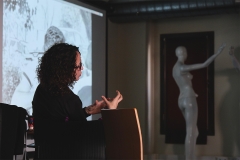
"Working with Found Footage" Workshop Organized with Zeyno Pekünlü
Artist, director, activist and academician Zeyno Pekünlü was the guest of CDM232: Digital Film Studio II.
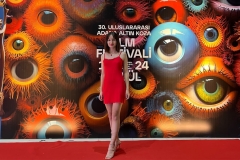
CDM senior year student Ecem has been selected to the Animation category at Adana Altın Koza Film Festival
CDM 4th-grade student Ecem Çörtle has been selected as a finalist in the National Student Films category of the 30th International Adana
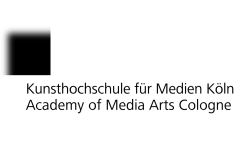
CDM graduate Eylül Berivan Kızılırmak has been accepted to the Cologne Academy of Media Arts
CDM graduate Eylül Berivan Kızılırmak has been accepted to the master's program at the Academy of Media Arts Cologne (Kunsthochschule für Medien Köln).
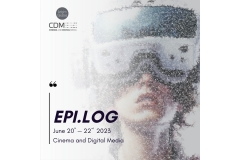
Traditionalistic CDM End of Year Exhibition EPI.LOG took place in FC Studios
Cinema and Digital Media End of Year Exhibition EPI.LOG 2023, organized as part of IUE Faculty of Communication Exhibition "FC-EX 2023", was
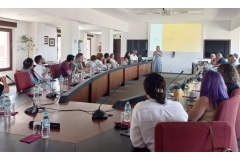
IUE Faculty of Communication Advisory Board members visited our Faculty and Studios on June 22, 2023
IUE Faculty of Communication Advisory Board members Andreas Treske, Ayşe Matay, Barbaros Görgü, Dilek Gappi, Elif Demirci İşleğen, Emine Uysal Berger, Murat
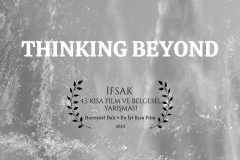
Ataberk awarded at the İFSAK 43rd National Short Film and Documentary Competition
Our third-year student, Ataberk Eyolcu, returned from the 43rd National Short Film and Documentary Competition of İFSAK (Istanbul Photography and Cinema Amateurs
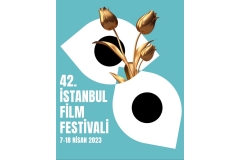
Our third-year CDM student Fikret Başar Kaya was at the 42nd Istanbul Film Festival
Our third year CDM student Fikret Başar Kaya participated as a Young Jury at the 42nd Istanbul Film Festival held on April
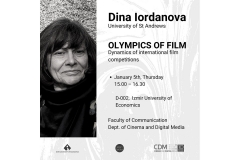
CDM hosted Dina Iordanova
Prof. Dina Iordanova gave a speech titled Olympics of Film: Dynamics of international film competitions on Thursday, January 5, 2023, in D002 at Izmir

